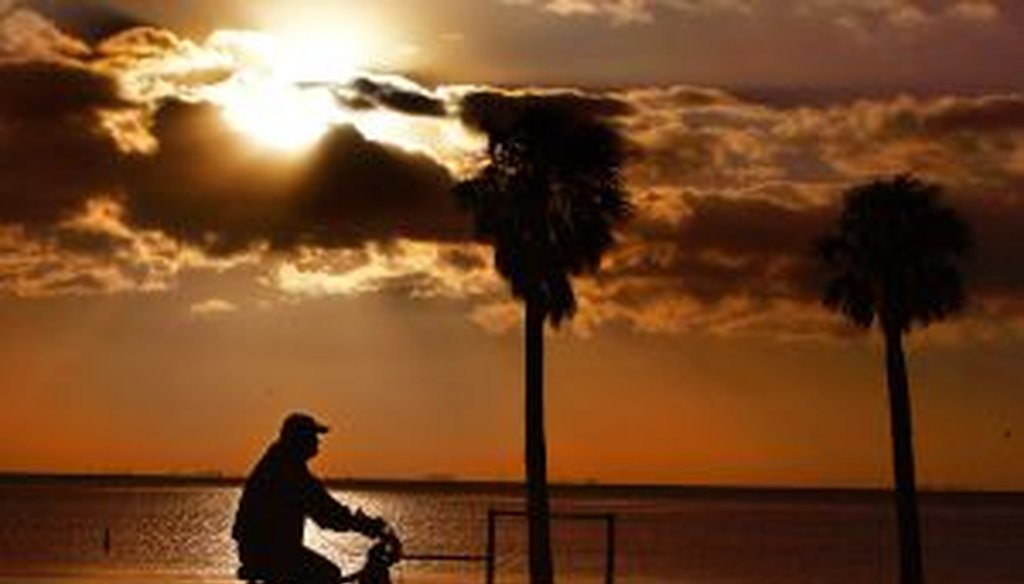Stand up for the facts!
Our only agenda is to publish the truth so you can be an informed participant in democracy.
We need your help.
I would like to contribute

A cyclist pedals along the St. Petersburg waterfront. (Times photo)
As St. Petersburg’s waterfront takes center stage in city politics once again, plenty of facts and figures about the coastline are bubbling to the surface.
One such chestnut is that the city enjoys the third-largest waterfront in all of North America, an honorific so pervasive it’s been repeated as fact by a city website, Oxy Clean pitchman Anthony Sullivan and even the Tampa Bay Times.
A city website touting "Surprising St. Pete" proclaims, "St. Pete has the third-largest downtown waterfront park in North America, behind only Chicago and Vancouver."
But is the trivia true? PolitiFact Florida decided to investigate.
The site had no source, but city marketing manager Robert Danielson said he believed they got it from the St. Petersburg-Clearwater Convention and Visitors Bureau. But Visit St. Pete-Clearwater deputy director David Downing told us he had "not heard of this superlative."
Vikas Mehta, an associate professor at the University of South Florida School of Architecture and Community Design, said he didn’t believe any such comparison exists. "It’s a hard one," Mehta said of the claim. "There really isn’t a reason for anyone to measure waterfronts or rank them."
Stumped, we turned to USF St. Pete history professor Ray Arsenault, the man who literally wrote the book on St. Petersburg. His St. Petersburg and the Florida Dream, 1888-1950 contains a comprehensive account of the city’s public waterfront and its creation. His response was surprising, to say the least.
"I think the city probably got it from me. I’m the culprit," Arsenault said. "I’ve been saying it for years, and they probably picked up on it."
Arsenault explained that back in the 1980s, he had been thinking about the largest public waterfronts to which he could compare St. Petersburg. He settled on two cities: Vancouver, British Columbia, which has Stanley Park, a 988-acre woodland park surrounded by a seawall, and Chicago’s waterfront, most notably its 18-mile Lakefront Trail on Lake Michigan. "It was my own kind of informal surveying of cities that kind of led to that," he said.
In the following decades, he used those cities as comparatives to highlight the uniqueness of the city’s waterfront during lectures, tours and speeches. At some point, his repeated analogy evolved into a correlation taken as fact, anointing St. Petersburg as having the third-largest downtown waterfront park in North America.
"I’ve said this dozens of times; I’ve said this in public. But I’ve never defined it," he said. "Maybe I shouldn’t have said it."
Before we could pillory the good professor for being careless, we wanted to investigate more. Maybe the statement could be proven, after all.
We turned to Susan Lucas, an author and researcher who has studied waterfront redevelopment. She told us the timing of Arsenault’s "informal surveying" came just as cities across America were becoming more interested in rejuvenating waterfronts.
"This legend, whatever it is, likely reached the public in the 1980s because that’s when waterfronts really expanded," said Lucas, who has done extensive analyses of land use along urban shorelines. "It took cities that long to realize waterfronts were actually valuable and could serve as tourist attractions. … In the case of Florida, waterfront spaces have always been tourist attractions. But even in Florida, it would be unusual to see these reserved as public spaces."
The waterfront park as we know it today was created in 1910, and was contentious from the start. Frank Allston Davis owned a small power plant where the St. Petersburg Yacht Club is now located, and he wanted to develop the city’s shoreline into a sprawling commercial harbor.
Times editor William Straub and real estate developer C. Perry Snell, champions of the "City Beautiful" movement, preferred a public space that could be enjoyed by all. The two men pooled their resources to covertly buy parcels of what was then a commercial shoreline in order to thwart Davis’ plans.
Straub and Snell deeded their land, paid for with their own money, to the city as public parkland — a plan met with some derision by many St. Petersburg taxpayers, who didn’t want the city wasting their dollars on "greenery and scenic walks," Arsenault wrote in his book.
"It was a small city. (Straub and Snell) wanted to keep as much waterfront as pristine as possible," Arsenault said. "They had a vision of a resort city, which was unusual. There were smaller towns with parks like that, but the idea of a city growing on tourism was a pretty novel idea."
This was before Snell Isle, Albert Whitted Airport or other dredging-intensive developments were built, of course. The city’s downtown public waterfront now is roughly 23 blocks, starting from Flora Wylie Park at the intersection of North Shore Drive NE and Coffee Pot Bayou Boulevard NE in the north. It ends all the way down past Demens Landing at First Avenue SE and Bay Shore Drive SE. Vinoy Park, North and South Straub Park and the Pier are all encompassed in that stretch.
If you throw out the requirement that all the land be contiguous, the city’s public waterfront property also includes Coffee Pot Park, Poynter Park, Lassing Park, Little Bayou Park and more.
Should all that be considered "downtown" waterfront? Actually, that further clouds the issue, Lucas told us. There is no universally accepted definition of downtown — whether it includes business districts or housing, if it has a historic designation, whether it is defined by the original platting of the city or beyond.
The city’s StPete.org website brags that "along the downtown waterfront, there are seven miles of lushly landscaped waterfront parks open to the public," which doesn’t help matters.
Even a gross measurement of the city’s entire waterfront area is a dicey proposition. StPete.org says the city has "244 miles of shoreline along Tampa Bay, Boca Ciega Bay, the Gulf of Mexico and intracoastal waterways," but notes 260 miles on another page. The National Oceanic and Atmospheric Administration told us either one could be correct -- once again, depending on how you measure it.
Without a concrete metric with which to measure St. Petersburg’s downtown waterfront against other metropolitan areas, there is no absolute way to compare St. Pete’s waterfront to anywhere, let alone Chicago or Vancouver.
We came to the conclusion that we couldn’t prove or disprove whether St. Petersburg is No. 3 for public downtown waterfronts; the evidence we found presented a mixed picture. So we’re not rating the claim on our Truth-O-Meter.
"I honestly don’t think it’s provable," Lucas said.
The other two cities Arsenault mentioned aren’t the best comparisons to St. Petersburg anyway, she added. All Canadian waterfront must be accessible to the public by law, Lucas said, and Chicago’s park system wasn’t always the jewel it is now, a common issue in municipal waterfronts.
"What you find in a lot of waterfronts is that public land used for recreation has a history of being railroad-run," she said. "Most public land is former railroad land sold to the state, or a superfund site, or land that is no longer suitable for anything beyond light recreation use."
That’s a far cry from St. Petersburg’s coast, which Lucas admits sounds quite impressive.
"Stereotypically, waterfronts these days are very disconnected from the city," Lucas said. "That (claim) conjures up images of miles of untouched beaches and sparkling blue water, as opposed to other waterfronts that are mixes of marinas, condos, restaurants and souvenir shops."
Like any good civic booster, Arsenault stands by his city, if not the offhand remarks that had morphed into something taken as truth. He said he isn’t quite sure why no other city worked to develop any sort of metric to measure their public spaces, but St. Petersburg certainly could continue to claim something unique.
"What it comes down to is we have a lovely waterfront park that, relative to the size of the city and its population, is a real treasure," he said. "There isn’t anything quite like it anywhere else."
Our Sources
City of St. Petersburg, Surprising St. Pete, accessed Aug. 1, 2013
Interview with Vikas Mehta, associate professor at the University of South Florida School of Architecture and Community Design, July 9, 2013
Interview with Ray Arsenault, USF St. Pete history professor, July 10, 2013
St. Petersburg and the Florida Dream, 1888-1950, by Ray Arsenault, 1988
Interview with Susan Lucas, waterfront redevelopment researcher and author, July 16, 2013
Email interview with Robert Danielson, St. Petersburg marketing manager, July 9, 2013
Email interview with David Downing, Visit St. Pete-Clearwater deputy director, July 9, 2013
Tampa Bay Times, Does the waterfront stack up?, 2010
Email interview with Cindy Fowler, National Oceanic and Atmospheric Administration GIS manager, Aug. 2, 2013


























